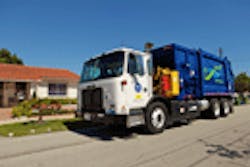Refuse fleets eyeing natural gas, hydraulic hybrids
DALLAS. Compressed natural gas and hydraulic hybrid systems are the big equipment news at this year’s Waste Expo show with most refuse haulers looking at the two alternative power options to help them save fuel and reduce carbon emissions. In the CNG camp, Mack Trucks, Navistar and Freightliner all rolled out new vocational trucks with packer bodies; Autocar, Peterbilt and Eaton showed off hybrid systems using hydraulic fluids to capture and store energy.
The Autocar E3 packer is powered by a full series hydraulic hybrid system supplied by the Parker Hannifin Corp. Called RunWise, it replaces a standard transmission with a hydrostatic drive module that allows it to capture kinetic energy on braking, which it stores by compressing hydraulic fluids. The unit provides all vehicle braking down to 5 MPH, generating as much as 500 HP for storage, according to Vance Zanardelli, Parker’s business unit manager for energy recovery. The truck then uses the compressed hydraulic fluid to drive the truck at all speeds under 42 MPH. Above 42, power is provided by the E3’s 380-hp Cummins ISL diesel linked in direct drive to the real axles.
In tests with Miami area refuse fleets, the E3 cut fuel consumption on collection routes by 42% servicing up to 1,000 houses a day, according to Zanardelli. Autocar has begun taking orders for the E3 and is in limited production. A delivery package van using the Parker system in a Freightliner Custom Chassis vehicle is also about to begin field testing, Zanardelli told Fleet Owner.
The hydraulics group of Eaton Corp. has taken a different approach, developing multiple hydraulic-based systems designed to reduce fuel consumption in refuse collection applications. Its hydraulic launch assist (HLA) system inserts a hydraulic pump/motor behind a standard transmission. In the stop-and-go of refuse collection, it captures energy on braking, which it stores by compressing hydraulic fluid in a holding tank, explains Corey Moore, the hydraulics group dir. of commercial vehicles. The pump then switches to motor mode to provide the initial seven to eight seconds of power for vehicle launch.
A fleet can choose to set the system for maximum fuel conservation, which can deliver up to a 20% improvement in MPG, or for faster launch performance to increase truck productivity, which will still offer a 14% to 15% fuel improvement, said Moore. Currently Peterbilt is offering the hydraulic hybrid system as a production option and Mack has begun trial installations.
With hydraulic systems such a major part of any refuse collection truck, Eaton has also looked to improve fuel economy by addressing pump efficiency with a new power-on-demand (POD) system. Unlike typical gear or van hydraulic pumps which run at full output all the time, Eaton’s POD system senses load requirements, providing only the amount of hydraulic pressure needed at any given time. Not only does that cut noise from the hydraulic system, but it brings fuel improvements of 6% to 12% in typical refuse collection applications, according to Moore.
With landfills capable of producing methane gas that can be used to run trucks with CNG engines and Federal incentives in place for fleets making the switch to natural gas, new refuse collection trucks fitted with NG systems were front and center at Waste Expo.
Mack brought its TerraPro COE fitted with a 9-liter, 320-HP Cummins Westport ISL G natural gas engine. Capable of running on compressed natural gas (CNG), liquefied natural gas (LNG) or landfill gas (LFG), the engine has a new three-way catalyst that allows it to meet EPA 2010 emissions standards. It is being offered in both the standard and low-cab-forward TerraPro models.
Freightliner’s alternative power option for the refuse market is its M2 112 Natural Gas model. Using the 320-HP ISL G engine, it has a stack of five CNG tanks that mount behind the cab and provide fuel capacity equivalent to 75 gallons of diesel. For fleets that need to mount a body that extends over the cab roof, a 4-tank storage option equal to 60 gallons of diesel is also available.
Navistar’s natural gas version of its International WorkStar vocational truck is powered by a modified version of the company’s own 7.6L MaxxForce DT engine. Producing a peak 300 HP and 860 lbs-ft. of torque, the engine’s conversion from diesel is handled by Emission Solutions Inc. (ESI), with the NG version installed off the assembly line once the truck is built, according to Melissa Gauger, Navistar’s vocational marketing manager. GVW ratings go up to 72,000 lbs for the CNG WorkStar, and the truck is 2010 EPA and CARB certified.
About the Author
Jim Mele
Jim Mele is a former longtime editor-in-chief of FleetOwner. He joined the magazine in 1986 and served as chief editor from 1999 to 2017.
